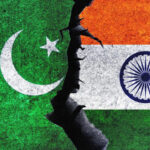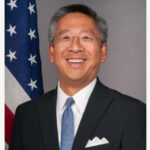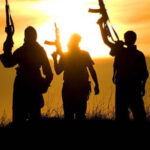The former three-time Prime Minister, who came back from a self-imposed exile in London, has daunting tasks ahead, from tackling the corruption cases against him to steering his party to victory at February’s polls despite the continued popularity of Imran Khan
The return of Mian Nawaz Sharif to Pakistan in October, and the relief he has received in cases against him ahead of elections on February 8 next year, prove that no one can ever be written off in Pakistani politics — as long as the military establishment is on their side. This isn’t the first time Mr. Sharif, who had been Prime Minister a record three times so far (1990-93, 1997-99 and 2013-17), has come back from foreign exile to massive crowds.
He had lived in Saudi Arabia after being dismissed in a coup and charged with treason over the hijacking of Gen. Pervez Musharraf’s flight in 1999, and returned to Pakistan to similar crowds in 2007. For the last few years, he lived in London, after he was disqualified in 2017 by the Supreme Court over undeclared assets that featured in the ‘Panama Papers’, and he was sentenced to 10 years in prison before he received medical bail.
His return on October 21 would not have been possible if the present military dispensation was not in favour of it. In a sense, Mr. Sharif, inarguably Pakistan’s most senior leader today, with a career in public office spanning half a century, has received that approval now, much as he did at the start of his political journey, groomed by the regime of Gen. Zia-ul-Haq, from the late 1970s.
At the time, a 30-year Nawaz Sharif was a businessman, learning the ropes at his father’s company, the Ittefaq Steel conglomerate. Mian Muhammad Sharif (known as Abbaji to all) was the stern patriarch for Nawaz Sharif, and his two younger brothers, Shehbaz and Abbas, and made most of their major life decisions and political choices for them. In his 20s, Mr. Sharif received a law degree at Punjab University in Lahore, and was known as a keen cricketer, although his professional career ended with a duck in a match playing for the Railways vs PIA (Pakistan International Airlines).
He was most remembered then for the flashy sports car that he drove around. In both their memoirs, former Pakistani Foreign Minister Khurshid Kasuri (Neither a Hawk Nor a Dove) and former Indian special envoy to Pakistan Satinder Lambah (In Pursuit of Peace) have made a special reference to the car, a Mercedes convertible, when they wrote about meeting Mr. Sharif in the 1970s.
For Mr. Kasuri, Mr. Sharif was the energetic new entrant to the Pakistan Tehrik-e-Istiqlal party that opposed Prime Minister Zulfiqar Ali Bhutto’s Pakistan People’s Party (PPP) in 1975 — the Sharif family business had been badly hit by Bhutto’s decision to nationalise its steel mills. For Mr. Lambah, then a diplomat in the Indian High Commission, Mr. Sharif was the amiable and charming member of the Lahore Chamber of Commerce, who drove him from the airport to a meeting in 1978. Shortly after, Mr. Sharif was chosen by Gen. Zia as the Provincial Minister of Finance. He became Punjab Chief Minister in 1985, and the Prime Minister of Pakistan in 1990. While Mr. Sharif’s life has seen many ups and downs, he still retains his youthful looks and charm, a love for luxury and for being a generous host, an interest in cricket, as well as in improving ties with India.
Political ideology
In addition, he has remained aligned to the political ideology he started out with: right-wing economics and fiscal conservatism to boost industry, and a religious conservatism that endeared him to Islamist forces unleashed by Gen. Zia, and seen in the Shariat Bill that he brought to Parliament in 1998.
This writer remembers his particular pride in building the M2 Islamabad-Lahore motorway, then the only such expressway in South Asia, which PM Benazir Bhutto halted during her tenure. While taking journalists to a rally ahead of the 1997 elections, he landed his helicopter right on the unfinished highway, vowing to complete the project (he did). Regardless of the criticism he faces for plunging Pakistan into debt, Mr. Sharif’s lasting legacy is in the boost to businesses, the motorway, the metro rail project, and then in 2015, inviting the Chinese Belt and Road Initiative projects across the country.
“Nawaz Sharif has been consistent in wanting to focus on expanding Pakistan’s economy by making it more market and investor-friendly and formulating a more realistic foreign policy, including good relations with India. But his approach to civil-military relations and working with (or against) domestic political opponents has varied,” said former Pakistani Ambassador to the U.S, Husain Haqqani, who is currently a scholar at Washington DC’s Hudson Institute and the Anwar Gargash Diplomatic Academy in Abu Dhabi. “He seems to have learned a lot from both his previous stints in power and his tribulations,” Mr. Haqqani told The Hindu.
In India, he is remembered for the many efforts he has made at reaching out, only to be reversed by the military, a terror attack or circumstances. His invitation to PM Atal Behari Vajpayee to come to Lahore seemed historic, but was followed by the Kargil war, although he denied he knew of the planned incursions at the time of the visit, blaming Gen. Musharraf for the whole debacle. He attempted to give India the MFN (most favoured nation) status, or what was called the Non- Discriminatory Market Access on Reciprocal Basis’ (NDMARB) during PM Manmohan Singh’s tenure, but the government changed during negotiations and the initiative flagged.
Mr. Sharif came to PM Narendra Modi’s swearing in ceremony, and then received him in Lahore on his birthday on December 25, 2015 in an effort to reset ties once again, and once again, the Pathankot terror attack, and Pakistan’s arrest of Kulbhushan Jadhav put paid to efforts by both sides to improve ties.
Trifecta of problems
During his 2013-17 tenure, PM Sharif and the Pakistan Muslim League (PML-Nawaz) lost much of their sheen due to his poor record in handling the trifecta of Pakistan’s problems — the debt-ridden economy, the Islamist militancy that carried out one of the worst terror attacks in 2014 at the Army School in Peshawar, and the military’s control of Pakistani politics, using the country’s three main parties, the PML-N, the PPP and Imran Khan’s Pakistan Tehreek-e-Insaf (PTI) to take one another down. This last factor has meant that no Prime Minister of Pakistan, including Mr. Sharif, has ever completed a full five-year term in office.
The fact that Mr. Sharif spent months in prison, with severe ailments that required surgery, and didn’t give up the political fight even from London, appears to have mitigated some of the negativity around his term in office. In addition, much of the blame for mismanagement has accrued to his brother Shehbaz Sharif, who ran the country during 2022-23, after the dismissal of PM Khan.
Despite the warm welcome back, Mr. Sharif has his work cut out: to manage the corruption cases against him so that he can stand for elections in February; to steer his party to victory at polls despite the continued popularity of Mr. Khan who remains in jail facing serious charges; and to ensure a smooth transition of power within his own party, to his daughter. Maryam Nawaz, at 50, is already a decade older than Mr. Sharif was, when he first took office as Prime Minister.
Nawaz Sharif | A new sheriff in town
The former three-time Prime Minister, who came back from a self-imposed exile in London, has daunting tasks ahead, from tackling the corruption cases against him to steering his party to victory at February’s polls despite the continued popularity of Imran Khan
The return of Mian Nawaz Sharif to Pakistan in October, and the relief he has received in cases against him ahead of elections on February 8 next year, prove that no one can ever be written off in Pakistani politics — as long as the military establishment is on their side. This isn’t the first time Mr. Sharif, who had been Prime Minister a record three times so far (1990-93, 1997-99 and 2013-17), has come back from foreign exile to massive crowds.
He had lived in Saudi Arabia after being dismissed in a coup and charged with treason over the hijacking of Gen. Pervez Musharraf’s flight in 1999, and returned to Pakistan to similar crowds in 2007. For the last few years, he lived in London, after he was disqualified in 2017 by the Supreme Court over undeclared assets that featured in the ‘Panama Papers’, and he was sentenced to 10 years in prison before he received medical bail.
His return on October 21 would not have been possible if the present military dispensation was not in favour of it. In a sense, Mr. Sharif, inarguably Pakistan’s most senior leader today, with a career in public office spanning half a century, has received that approval now, much as he did at the start of his political journey, groomed by the regime of Gen. Zia-ul-Haq, from the late 1970s.
At the time, a 30-year Nawaz Sharif was a businessman, learning the ropes at his father’s company, the Ittefaq Steel conglomerate. Mian Muhammad Sharif (known as Abbaji to all) was the stern patriarch for Nawaz Sharif, and his two younger brothers, Shehbaz and Abbas, and made most of their major life decisions and political choices for them. In his 20s, Mr. Sharif received a law degree at Punjab University in Lahore, and was known as a keen cricketer, although his professional career ended with a duck in a match playing for the Railways vs PIA (Pakistan International Airlines).
He was most remembered then for the flashy sports car that he drove around. In both their memoirs, former Pakistani Foreign Minister Khurshid Kasuri (Neither a Hawk Nor a Dove) and former Indian special envoy to Pakistan Satinder Lambah (In Pursuit of Peace) have made a special reference to the car, a Mercedes convertible, when they wrote about meeting Mr. Sharif in the 1970s.
For Mr. Kasuri, Mr. Sharif was the energetic new entrant to the Pakistan Tehrik-e-Istiqlal party that opposed Prime Minister Zulfiqar Ali Bhutto’s Pakistan People’s Party (PPP) in 1975 — the Sharif family business had been badly hit by Bhutto’s decision to nationalise its steel mills. For Mr. Lambah, then a diplomat in the Indian High Commission, Mr. Sharif was the amiable and charming member of the Lahore Chamber of Commerce, who drove him from the airport to a meeting in 1978. Shortly after, Mr. Sharif was chosen by Gen. Zia as the Provincial Minister of Finance. He became Punjab Chief Minister in 1985, and the Prime Minister of Pakistan in 1990. While Mr. Sharif’s life has seen many ups and downs, he still retains his youthful looks and charm, a love for luxury and for being a generous host, an interest in cricket, as well as in improving ties with India.
Political ideology
In addition, he has remained aligned to the political ideology he started out with: right-wing economics and fiscal conservatism to boost industry, and a religious conservatism that endeared him to Islamist forces unleashed by Gen. Zia, and seen in the Shariat Bill that he brought to Parliament in 1998.
This writer remembers his particular pride in building the M2 Islamabad-Lahore motorway, then the only such expressway in South Asia, which PM Benazir Bhutto halted during her tenure. While taking journalists to a rally ahead of the 1997 elections, he landed his helicopter right on the unfinished highway, vowing to complete the project (he did). Regardless of the criticism he faces for plunging Pakistan into debt, Mr. Sharif’s lasting legacy is in the boost to businesses, the motorway, the metro rail project, and then in 2015, inviting the Chinese Belt and Road Initiative projects across the country.
“Nawaz Sharif has been consistent in wanting to focus on expanding Pakistan’s economy by making it more market and investor-friendly and formulating a more realistic foreign policy, including good relations with India. But his approach to civil-military relations and working with (or against) domestic political opponents has varied,” said former Pakistani Ambassador to the U.S, Husain Haqqani, who is currently a scholar at Washington DC’s Hudson Institute and the Anwar Gargash Diplomatic Academy in Abu Dhabi. “He seems to have learned a lot from both his previous stints in power and his tribulations,” Mr. Haqqani told The Hindu.
In India, he is remembered for the many efforts he has made at reaching out, only to be reversed by the military, a terror attack or circumstances. His invitation to PM Atal Behari Vajpayee to come to Lahore seemed historic, but was followed by the Kargil war, although he denied he knew of the planned incursions at the time of the visit, blaming Gen. Musharraf for the whole debacle. He attempted to give India the MFN (most favoured nation) status, or what was called the Non- Discriminatory Market Access on Reciprocal Basis’ (NDMARB) during PM Manmohan Singh’s tenure, but the government changed during negotiations and the initiative flagged.
Mr. Sharif came to PM Narendra Modi’s swearing in ceremony, and then received him in Lahore on his birthday on December 25, 2015 in an effort to reset ties once again, and once again, the Pathankot terror attack, and Pakistan’s arrest of Kulbhushan Jadhav put paid to efforts by both sides to improve ties.
Trifecta of problems
During his 2013-17 tenure, PM Sharif and the Pakistan Muslim League (PML-Nawaz) lost much of their sheen due to his poor record in handling the trifecta of Pakistan’s problems — the debt-ridden economy, the Islamist militancy that carried out one of the worst terror attacks in 2014 at the Army School in Peshawar, and the military’s control of Pakistani politics, using the country’s three main parties, the PML-N, the PPP and Imran Khan’s Pakistan Tehreek-e-Insaf (PTI) to take one another down. This last factor has meant that no Prime Minister of Pakistan, including Mr. Sharif, has ever completed a full five-year term in office.
The fact that Mr. Sharif spent months in prison, with severe ailments that required surgery, and didn’t give up the political fight even from London, appears to have mitigated some of the negativity around his term in office. In addition, much of the blame for mismanagement has accrued to his brother Shehbaz Sharif, who ran the country during 2022-23, after the dismissal of PM Khan.
Despite the warm welcome back, Mr. Sharif has his work cut out: to manage the corruption cases against him so that he can stand for elections in February; to steer his party to victory at polls despite the continued popularity of Mr. Khan who remains in jail facing serious charges; and to ensure a smooth transition of power within his own party, to his daughter. Maryam Nawaz, at 50, is already a decade older than Mr. Sharif was, when he first took office as Prime Minister.






NO COMMENT